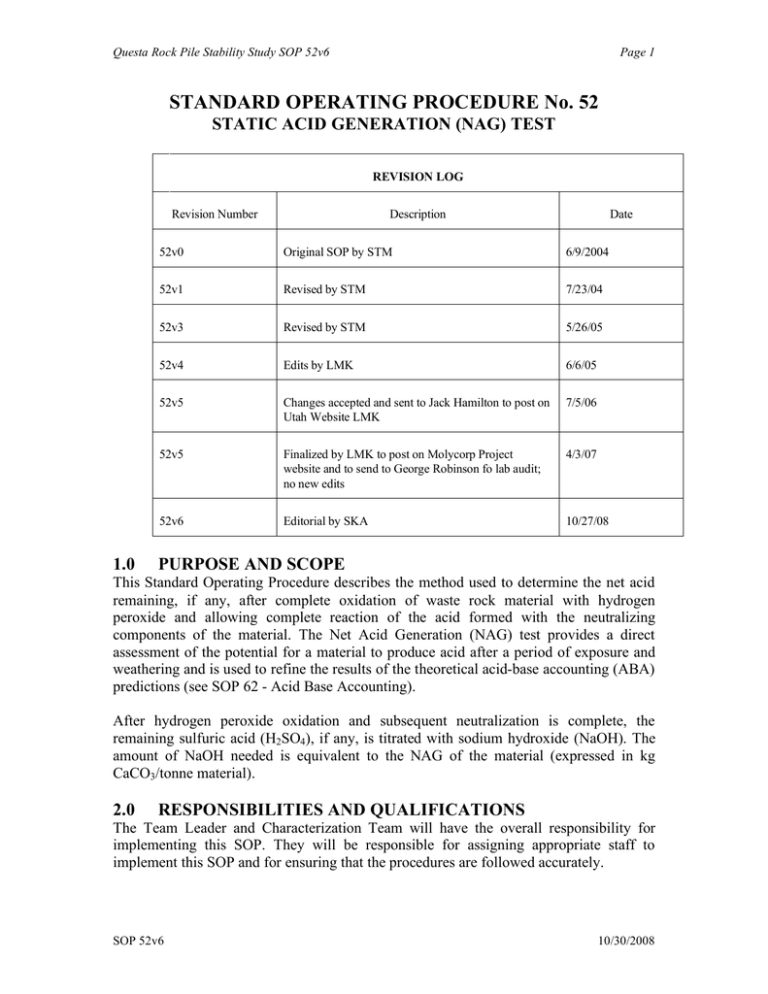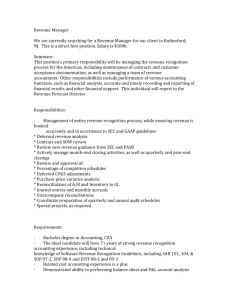STANDARD OPERATING PROCEDURE No. 52 STATIC ACID GENERATION (NAG) TEST
advertisement

Questa Rock Pile Stability Study SOP 52v6 Page 1 STANDARD OPERATING PROCEDURE No. 52 STATIC ACID GENERATION (NAG) TEST REVISION LOG Revision Number 1.0 Description Date 52v0 Original SOP by STM 6/9/2004 52v1 Revised by STM 7/23/04 52v3 Revised by STM 5/26/05 52v4 Edits by LMK 6/6/05 52v5 Changes accepted and sent to Jack Hamilton to post on Utah Website LMK 7/5/06 52v5 Finalized by LMK to post on Molycorp Project website and to send to George Robinson fo lab audit; no new edits 4/3/07 52v6 Editorial by SKA 10/27/08 PURPOSE AND SCOPE This Standard Operating Procedure describes the method used to determine the net acid remaining, if any, after complete oxidation of waste rock material with hydrogen peroxide and allowing complete reaction of the acid formed with the neutralizing components of the material. The Net Acid Generation (NAG) test provides a direct assessment of the potential for a material to produce acid after a period of exposure and weathering and is used to refine the results of the theoretical acid-base accounting (ABA) predictions (see SOP 62 - Acid Base Accounting). After hydrogen peroxide oxidation and subsequent neutralization is complete, the remaining sulfuric acid (H2SO4), if any, is titrated with sodium hydroxide (NaOH). The amount of NaOH needed is equivalent to the NAG of the material (expressed in kg CaCO3/tonne material). 2.0 RESPONSIBILITIES AND QUALIFICATIONS The Team Leader and Characterization Team will have the overall responsibility for implementing this SOP. They will be responsible for assigning appropriate staff to implement this SOP and for ensuring that the procedures are followed accurately. SOP 52v6 10/30/2008 Questa Rock Pile Stability Study SOP 52v6 Page 2 All personnel performing these procedures are required to have the appropriate health and safety training. In addition, all personnel are required to have a complete understanding of the procedures described within this SOP, and to receive specific training regarding these procedures, if necessary. All chemistry laboratory staff are responsible for reporting deviations from this SOP to the Team Leader. 3.0 DATA QUALITY OBJECTIVES This SOP addresses objectives 1 and 2 in the data quality objectives outlined by Virginia McLemore for the "Geological and Hydrological Characterization at the Molycorp Questa Mine, Taos County, New Mexico”. • Determine how the hydrogeochemistry and water balance dynamics influence rock pile weathering and stability. • Determine how mineralogy, stratigraphy, and internal structure of the rock piles contribute to weathering and stability. 4.0 RELATED STANDARD OPERATING PROCEDURES The procedures set forth in this SOP are intended for use with the following SOPs: SOP 1 Data management (including verification and validation) SOP 2 Sample management (chain of custody) SOP 3 Surveying (GPS) SOP 5 Sampling outcrops, rock piles, and drill core (solid) SOP 6 Drilling, logging, and sampling of subsurface materials (solid) SOP 8 Sample preparation (solids) SOP 9 Test pit excavation, logging, and sampling (solid) SOP 11 Paste pH and paste conductivity SOP 22 Analytical data validation SOP 36 Sample preservation, storage, and shipment SOP 62 Acid-base accounting 5.0 EQUIPMENT LIST • • • • • • • • • • • • • • Appropriate sample containers with weatherproof labels & pens A pH meter with combination pH electrode pH 4 and pH 7 calibration standards Deionized (DI) water Titration Data sheet (Appendix 1) 500 mL wide-mouth conical flask or equivalent Watch glass Weighing paper or aluminum foil Magnetic stirrer Fume hood Hot plate Thermometer Burette (50 mL) with stand and clamp Chemical balance reading to at least 2 decimal places in grams SOP 52v6 10/30/2008 Questa Rock Pile Stability Study SOP 52v6 • • • • • 6.0 Page 3 Helium water-degassing apparatus Ascarite tube Wash bottles for DI water Other glass and plastic beakers as may be needed Reagents as listed below REAGENTS 1. 15% Hydrogen Peroxide (H2O2) solution: dilute Hydrogen Peroxide Reagent Grade 30% with DI water at a ratio of 1:1 to 15%. Make sure the pH is between 5 and 6 (see section 10.0). 2. Certified grade, 0.1 Normal (N) hydrochloric acid, for standardization of bases 3. Carbon dioxide-free DI water. Use the helium water-degassing apparatus to bubble out gasses from the DI water, then pour degassed water into a container equipped with an ascarite tube. 4. Approximately 0.5 N sodium hydroxide, standardized: Dissolve 20.0g of NaOH pellets in carbon dioxide-free water and dilute to 1 liter. Protect from CO2 in the air with an ascarite tube. Standardize the solution by placing 50 mL of certified 0.1 N HCl in a beaker and titrating with the prepared 0.5 N NaOH until a pH of 7.00 is obtained. Calculate the Normality of the NaOH using the following equation: N2 = N 1V1 V2 Where: V1 = Volume of HCl used N1 = Normality of HCl used V2 = Volume of NaOH used N2 = Calculated normality of NaOH 5. Approximately 0.1 N sodium hydroxide, standardized: Dilute 200 ml of 0.5 N NaOH with carbon dioxide-free DI water to a volume of 1 liter. Or dissolve 4.0g of NaOH pellets in carbon dioxide-free water and dilute to 1 liter. Protect from CO2 in air with the ascarite tube. Standardize the solution by placing 20 ml of certified 0.1 N HCl in a beaker and titrating with the prepared 0.1 N NaOH until a pH of 7.00 is obtained. Calculate the normality of the NaOH using the equation above. 7.0 PROCEDURES 1. Weigh 2.50g of pulverized sample into a 500 mL wide-mouth conical flask. SOP 52v6 10/30/2008 Questa Rock Pile Stability Study SOP 52v6 Page 4 2. Add 250 mL of 15% H2O2 to the sample, cover the flask with a watch glass and place it in a fume hood or well-ventilated area. The H2O2 should be at room temperature before commencing the test. 3. Allow the sample to react until ‘boiling’ or effervescing ceases. This may take days to a week. The NAG reaction can be vigorous and sample solutions can ‘boil’ at temperatures of up to 120oC. Great care must be taken to place samples in a wellventilated area or fume hood. 4. Heat the sample on a hot plate and gently boil for 2 hours. Do not allow sample to boil dry – add DI water if necessary. 5. Allow the solution to cool to room temperature, then record the final pH (NAG pH). 6. Rinse the sample that has adhered to the sides of the flask down into the solution with DI water. Add DI water to give a final volume of 250 mL. 7. Measure the pH of the final NAG solution. If the pH is greater than or equal to 4.5, end the test there. If the pH is less than 4.5, titrate the solution to pH 4.5 with NaOH solution of the appropriate concentration based on final NAG solution pH as in Table 1 below. Table 1: Concentration of NaOH Solution to use for Titration NAG Solution pH Reagent NaOH Concentration >2.5 5 0.10 N <2.5 4 0.50 N 8.0 CALCULATIONS The NAG capacity is determined as follows: Net Acid Generation NAG = 50 * V * N W Where: NAG = net acid generation (kg CaCO3/tonne) V = volume of base NaOH titrated (mL) N = normality of base NaOH (eq/L) W = weight of sample reacted (g) 9.0 DOCUMENTATION Record all test stages including dates, sample IDs, NAG pH, and the pH of the final 250 mL solution in the NAG test notebook. Note any deviations from the SOP or unexpected SOP 52v6 10/30/2008 Questa Rock Pile Stability Study SOP 52v6 Page 5 events in the notebook. Record details of titration on the Titration Data Sheet (Appendix 1). Record volume of solution titrated against pH of sample solution for different pH values until the pH just passes 4.50. Plot the data from the Titration Data Sheet on a graph sheet and estimate the actual volume of NaOH titrated at pH 4.5. Calculate the NAG value with the equation in 8.0 and record the results in the NAG Table (Appendix 1) in the Molycorp Database. 10.0 QUALITY ASSURANCE/QUALITY CONTROL The pH of the H2O2 used in the NAG test should be checked to ensure it is approximately 5.5. If the pH is less than 5, then add dilute NaOH (use a solution made up by adding 1 g NaOH to 100 mL DI water) until the pH is greater than 5 (aim for a pH between 5 and 6). The pH is adjusted to greater than pH 5 to ensure that the phosphoric acid, used to stabilize H2O2 in some brands, is neutralized. The pH of the 15% H2O2 should always be checked to ensure that any stabilizing acid is neutralized; otherwise, false positive results may be obtained. Calibrate the pH meter according to the manufacturer’s instructions before each titration. If, in the course of titration, the pH meter is suspected to be reading inaccurately, check with the pH 7.0 buffer and recalibrate the meter if it is off by more than 0.05 units. Run one duplicate sample for every 5 samples tested within a batch. Also, run between batch duplicates: test a duplicate of one sample in each batch during the next batch of tests. A duplicate of this sample should have been tested when testing its own batch. 11.0 REFERENCE 1. Miller, S., Robertson, A., and Donohue, T. (1997). Advances in Acid Drainage Prediction Using The Net Acid Generation (NAG) Test. In: Proceedings of the Fourth International Conference on Acid Rock Drainage, Vancouver, B.C., Canada, 1997, vol II, pp. 535-547. SOP 52v6 10/30/2008 Questa Rock Pile Stability Study SOP 52v6 Page 6 APPENDIX I. FORMS Form A: Titration Data Sheet Titration Data Sheet Sample ID Sample ID Date Date Volume of Solution (mL) Initial Burrette Reading (mL) Initial pH of solution Volume of Solution (mL) Initial Burrette Reading (mL) Name and Concentration of Titrant Initials of Technician Name and Concentration of Titrant Initials of Technician Titration Volume (mL) Comments SOP 52v6 Initial pH of solution Titration pH Volume (mL) pH Comments 10/30/2008 Questa Rock Pile Stability Study SOP 52v6 Page 7 Form B: NAG Table in Molycorp Database SOP 52v6 10/30/2008


